What are Bar Lines in Music, and What do They do?
Bar lines are primarily used to let musicians know when the measure ends. They are vertical lines written through the music staff or staves. By showing where the measures end, bar lines help musicians quickly see the fundamental organizational structure of written music: the measure.
Bar lines make music much easier to read by visibly breaking music into smaller chunks. Breaking music into smaller chunks helps musicians track where the downbeat is. This helps musicians play the music with the proper pulse, which is the most essential element of musicality. For more on pulse and rhythm, check out my guide on learning to read rhythm.


There are many types of bar lines. While the most common bar line, the single vertical bar line, helps musicians understand the small-scale structure of the measure, many other bar line types exist to help musicians understand the larger-scale structure of the music, including where sections end, when to repeat music, and more.
Music has many parallels to spoken language, but it is essential for the beginning musician to understand that the bar line is not like a period.
- It does not indicate the end of a musical idea or musical sentence.
- In fact, a complete musical idea, called a phrase, almost always takes multiple measures to unfold.
- A musical phrase almost never ends at a bar line.
- It is most common for musical ideas to end on the downbeat right after a bar line.
(If you're thinking, "What is this guy talking about? Most pieces of music end at the bar line!", that's not quite right. Most pieces of music end on beat 1 with either a long note or a short note followed by rests.)
Interestingly, the bar line only came into use late in the 16th century. In fact, one of the most prominent places that bar lines showed up was in tablature (tab) music for a grandfather of the guitar, the Spanish Vihuela. That's right, guitarists; guitar tab is 400+ years old and predates today's standard music notation!
Why You Should Trust Me
I've been teaching guitar lessons to students of all ages since 2006, from children and adults who are absolute beginners all the way through courses and private lessons at Swarthmore College.
How To Read Bar Lines
Understanding bar lines is an essential part of learning to read music. It will help make you a better musician by helping you understand the structure of music. They'll also help the beginning music reader ensure they read rhythms correctly.
However, with one exception, you don't need to learn how to read them. Here's why: They aren't instructions on what to play (with one exception); they are aids in helping you understand the music.
Now, Let's understand what the different types of bar lines mean and how they are used. And, importantly, find the one exception you need to know how to read!
Common Bar Lines
Single Bar Line
The Single Bar line is the fundamental type of bar line. It simply indicates that a measure is ending.
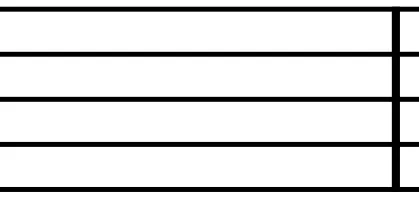
Double Bar Line
A double-bar line is typically used to show that a large section of music is ending. You may notice a shift in the character of the music after this sort of bar line. It can also be used to indicate the end of a piece.
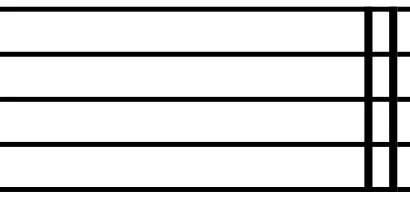
Final Bar Line
A variant of the Double Bar Line with one light and one heavy line. The Final Bar line is used at the end of the piece.
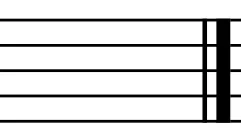
Repeat Signs
You must learn and memorize what these mean. They indicate that some music is to be repeated. Below the pictures, I explain how to read repeat signs.

Begin Repeat

End Repeat
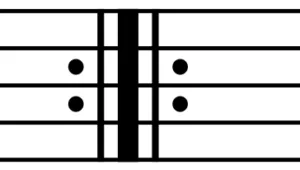
Double Repeat
Begin Repeat Sign (optional)
This indicates the Beginning of the section of music to be repeated (you won't always see it; it's optional in some situations). When you arrive at this the first time, simply make note of it and keep playing the music.
The beginning repeat sign is typically used when the composer only wants the player to repeat a portion of the music.
End Repeat Sign
This indicates the end of a section of music to be repeated. The section will be repeated 1 time unless otherwise indicated.
When you see this, you need to figure out how far back to go to begin your repeat.
If you had previously passed a begin-repeat sign, go back to that spot and repeat the music. If there is no begin repeat sign, simply repeat from the beginning.
Here are two examples, one without the beginning repeat sign and one with.
I will use |: to indicate beginning repeat and 😐 to indicate ending repeat.
Without the beginning repeat:
A A B B C C D D 😐
is played
A A B B C C D D
A A B B C C D D
With the beginning repeat sign:
A A B B |: C C D D 😐
is played
A A B B C C D D
C C D D
Double Repeat Sign
The double repeat sign is the combination of an end repeat sign and a beginning repeat sign. It indicates that the material on either side of it is to be repeated. So, if we had two sections of music (A and B) and wanted both repeated (A A B B), we could write it using
- A Begin Repeat sign
- The A section Music
- A Double Repeat Sign
- The B Section Music
- An End Repeat Sign
It would look something like this (:||: used as the Double Repeat Sign) |: A section :||: B Section 😐
Reverse Final Bar Line
Stuck somewhere between common and uncommon bar lines, this double-bar line variant also indicates the end of a section. You can expect the character shift in the music to be more drastic that the use of a simple Double Bar Line; for example, the music might end a section and begin a new one in a new key.
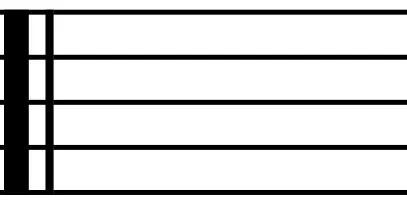
Uncommon Bar Lines

Winged Double Repeat Sign
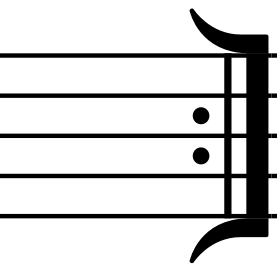
Winged Repeat Sign
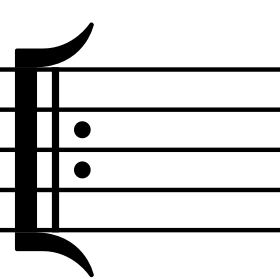
Winged Repeat Sign

Heavy Double Bar Line

Heavy Bar Line

Dotted Bar Line

Half Bar Line
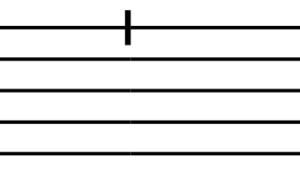
Tick Bar Line
The winged repeat signs function precisely the same as regular repeat signs and are a stylistic choice.
Heavy versions of more common bar lines, like the Heavy Double Bar Line and Heavy Bar Line, can be used in pieces with more structural complexity. Heavy Bar lines would indicate larger structural sections or breaks, and the standard bar lines would indicate smaller sections within them. In fact, they function much like the text on this page; the largest text denotes the largest structural ideas (headings), and the smaller text denotes smaller ideas (subheadings).
The Dotted Bar Line (and its cousin, the Dashed Bar Line, not shown) can be used in uncommon meters like 5/4 to help the reader understand where the mid-measure musical emphasis should happen.
The Half Bar Line and Tick Bar Line are most common in plainsong, where they indicate a slight gap or breath between phrases. They are also used in modern editions of music that predate the bar line's use. These are used to help the reader understand the structure but indicate that there may not be a stress on the "downbeat" following these bar lines.
Conclusion
If you're learning to read notes and confused about how the bar line affects accidentals, I highly recommend checking out my article on Accidentals in Music (where you'll learn all about The Bar Line Rule, with memes).
If you're still learning to read music, or just looking for the fastest way to learn to read notes (that they won't even teach you in college, even though it teaches you to read every note and every staff at the same time with maximum understanding and minimal effort), then I recommend my article on how to read music notes.
Continue learning
Most musicians don’t struggle with rhythm because they lack talent. They struggle with rhythms because they were taught them using a backward teaching method. Here’s an example from my own education: In Conservatory, I spent weeks stuck on a single beat in a giant piece of music. I visited my professor’s office, desperate for answers, but
Welcome to my article on polyrhythms. Right now, you might be thinking that figuring out the the polyrhythm staring back at you from your sheet music is an imposible task. Or maybe you’re frustrated at being unable to recreate the rhythms that you hear. Or maybe, just maybe, you’re like I was 20 years ago;
Understanding sharps, flats, and naturals is essential in learning how to read music and understand basic music theory. This article will dive deeply into sharps, flats, and naturals. By the time you’re done, you’ll know just about everything there is to know about sharps and flats. In fact, you might know too much. C C
Have you finally realized that your rhythm & timing aren’t quite up to snuff, and you’re finally ready to learn to use the metronome? Look no further because I’ve got the perfect guide for you. I’ll teach you how to use a metronome to improve your musical timing and rhythm so that you can find


